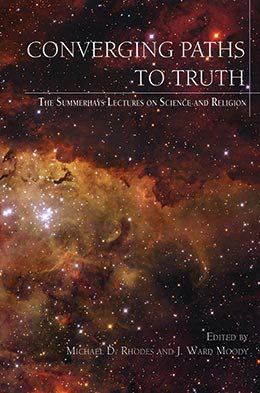Introduction

Introduction
In the fall of 2002, Briant Summerhays, J. Ward Moody, and Michael D. Rhodes proposed that Religious Education and the College of Physical and Mathematical Sciences sponsor a lecture series at BYU to promote faithful dialogue on science and religion. The goal was to create a forum where men and women of faith could share insights on how the truths of revealed religion mesh with knowledge from the sciences. The proposal was accepted, and the lecture series was named in honor of Briant’s father, Hyrum Barrett Summerhays, a lifelong friend and benefactor of astronomy at BYU. The first lecture was delivered in the Harold B. Lee Library auditorium on March 21, 2003. The last was delivered in fall 2008.
The Summerhays lectures are of worth to students of both science and religion because the logic and reason that are the foundations of science are also hallmarks of true religion. Many great scientists, such as Isaac Newton and Albert Einstein, spoke and wrote freely of their religious thoughts and feelings, seeing no fundamental conflict between them and their science. It is no coincidence that many great universities which have nurtured the rise of science since the middle ages were founded and supported by religious organizations seeking truth.
The amity, though, which has existed between practitioners of science and devotees of faith has drifted in modern times toward enmity. There is a tendency now to emphasize conflict more than harmony. Sometimes people of faith are criticized as being blind, naive, or credulous, while scientists are painted as arrogant, unfeeling, or deceived. Educated dialogue between these two camps has too often been reduced to shallow platitudes or, even worse, silence.
Truth is not in conflict with itself. Religious truth is established through revelation. Scientific inquiry has uncovered many facts that have thus far stood the test of time and must also contain truth. It is incumbent upon scholars to seek insights into all truth and mesh together, where possible, its parts at their proper interface.
The opportunity to explore science in light of revealed truth is an obligation of scholars at BYU, who, in the words of Brigham Young to Karl G. Maeser, should not even “teach the alphabet or the multiplication tables without the Spirit of God.”[1] We are also taught by the Savior in Doctrine and Covenants section 9 that we must first study things out in our minds before their accuracy and truth will be affirmed or denied to us. Thus it becomes our duty to actively search for truth and plead for the Holy Ghost to affirm or deny the truthfulness of our thoughts after we have had them. We discover bridges between scientific and religious knowledge best if we pursue them through study, faith, and dialogue. The Summerhays lectures are dedicated to that pursuit.
These lectures took place at or near the time of the vernal and autumnal equinoxes, approximately March 21 and September 22. The significance of these times to astronomy is apparent. It is when the days and nights are each twelve hours long, signaling the beginning of spring or fall. The vernal equinox occurs around the time of the Savior’s birth and the time of the First Vision. The autumnal equinox occurs near the time when Moroni appeared to Joseph Smith for five successive tutorials, preparing him for the translation of the golden plates, which he turned over to Joseph after the last meeting. The dual significance of these dates made them the natural choice for these lectures.
A total of nine lectures were given by BYU faculty members between fall 2003 and fall 2008. We are grateful to the participants for putting their presentations in written form for inclusion in this volume. All talks presented in the series are included here with the sole exception of the excellent presentation on geological time by Dr. Bart Kowallis, whose time demands as an active researcher and department chairman were considerable.
We are indebted to Briant Summerhays for the generous support that has made these lectures possible. We are most grateful to Brent Hall and Deans Earl Woolley, Scott Sommerfeldt, Andrew Skinner, and Terry Ball for their counsel and guidance both with us and on our behalf as we have labored with the logistics of putting this series together.
It is our hope that this volume will be a worthy basis for faithful and intelligent dialogue among all interested people.
Notes
[1] Reinhard Maeser, Karl G. Maeser: A Biography (Provo, UT: Brigham Young University, 1928), 79.
